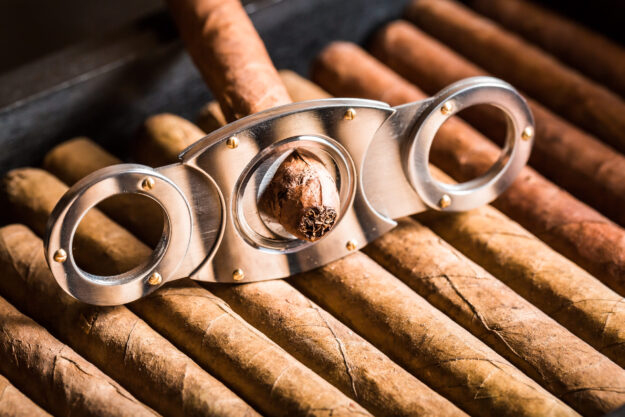Cutting a cigar is a crucial step in ensuring a smooth and enjoyable smoking experience. A proper cut allows for a balanced draw, ensuring that the flavors of the cigar are evenly distributed with each puff. Here’s how you can master the art of cutting a cigar.
Why the Cut Matters
The cut of a cigar directly affects the draw, which is how easily the smoke passes through the cigar. A clean cut prevents the wrapper from unraveling and ensures that the cigar burns evenly. A poor cut, on the other hand, can lead to an uneven burn, harsh smoke, or a compromised draw.
Choosing the Right Cutter
Before cutting your cigar, it’s essential to select the right tool. The most common types of cigar cutters include:
- Guillotine Cutter: The most popular choice, it features a single or double blade that slices straight across the cigar’s cap.
- V-Cutter: This cutter creates a v-shaped notch in the cap, offering a concentrated draw with more intensity.
- Punch Cutter: This tool punches a small hole in the cap, preserving more of the cigar’s structure and producing a tighter draw.
Your choice of cutter can influence the smoking experience, so it’s worth experimenting with different styles to see which one you prefer.
Step-by-Step Guide to Cutting a Cigar
- Inspect the Cigar: Begin by examining your cigar. Identify the cap, the small piece of tobacco leaf that covers the head of the cigar. The cap holds the wrapper together, so it’s important to cut just above the cap line.
- Position the Cutter: Hold the cigar in one hand and the cutter in the other. Place the cigar’s head into the cutter and align the blades just above the cap line. Ensure the cut will be clean and not too deep—about 1/16 to 1/8 of an inch is ideal.
- Make the Cut: In one swift, confident motion, close the cutter to slice through the cigar. Avoid a slow or hesitant cut, as this can cause the wrapper to tear or unravel. A clean, quick cut ensures a smooth smoking experience.
- Check the Draw: Before lighting, test the draw by taking a dry puff. The airflow should be free and easy, without being too loose or too tight. If the draw feels restricted, the cut may not have been deep enough; if it’s too loose, the cut may have been too aggressive.
- Ready to Smoke: With your cigar properly cut, you’re now ready to light it and enjoy the full range of flavors. Take your time and savor the experience, knowing that your preparation has set the stage for a perfect smoke.
Common Mistakes to Avoid
- Cutting Too Deep: If you cut too much off the cap, the wrapper may unravel, ruining the cigar.
- Using a Dull Cutter: A dull blade can crush or tear the cigar instead of slicing cleanly, leading to an uneven draw.
- Inconsistent Cuts: Make sure to cut the cigar in a single, smooth motion to avoid jagged edges or a crooked cut.
Conclusion
Cutting a cigar is more than just a preparatory step—it’s an essential part of the cigar-smoking ritual. By mastering the technique, you ensure that each smoke is as satisfying as possible, with a smooth draw, even burn, and full flavor. Whether you’re new to cigars or a seasoned aficionado, a well-executed cut is the first step to a great smoking experience.


